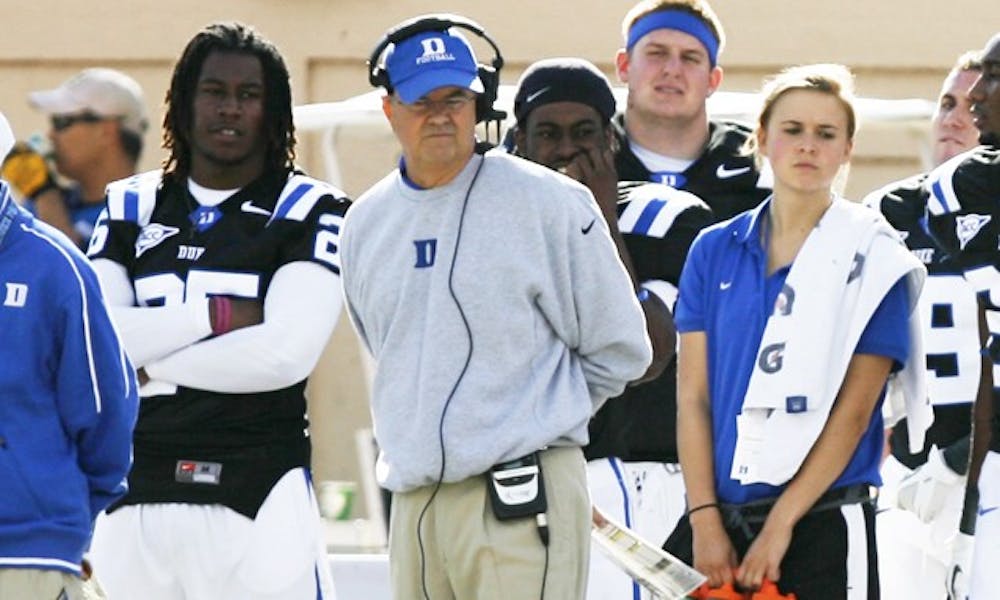November is the month that college football’s top teams traditionally spend with their eyes on capturing a conference title, or at the least securing an invitation to a high-profile bowl game. Everything that happens up until the calendar is flipped for the last month of the regular season goes out the window—it’s a new season.
Unfortunately, November has been less of a fresh start for the Blue Devils and more of the beginning of an annual tailspin.
Since the arrival of head coach David Cutcliffe, who is in his fourth season as the program’s architect, Duke has a record of 1-13 in the month. And last Saturday’s crushing defeat at the hands of Miami was not a step toward reversing this negative momentum.
It seems that at the beginning of every fall, fans and pundits alike wonder whether the upcoming season will finally be the one when Cutcliffe secures the program its first bowl berth since the 1994 season. Well, I can guarantee one thing—if the late-season play isn’t improved to at least a respectable level, the Blue Devils will not be making a postseason appearance for quite some time.
For a team whose coaching staff prides itself upon the pillars of discipline and conditioning from the first day of spring practice, one would expect it to hold up better with winter approaching. I walked around the locker room during the program’s midweek media session searching for some sort of explanation for the lackluster finishes to the past few seasons, but I couldn’t find any sort of consensus answer. And some players, even quarterback and team captain Sean Renfree, were dumbfounded as to the source of the struggles.
“I was thinking about [the November losses] earlier,” Renfree said. “I can’t really put a finger on what it is. It’s hard to say. I wish I could give you a explanation.”
Also a bit disconcerting was the reaction I received from senior Jay Hollingsworth, a guy that has endured all four years of the Cutcliffe rebuilding plan. The backup running back seemed startled by the fact that he has only taken part in one November victory.
“That’s definitely tough that we’ve only won one game,” Hollingsworth said. “The saying is ‘teams remember what you do in November,’ and we haven’t done much.”
Other players pointed to injuries and depth issues as part of the reason for the dismal play during the last third of the schedule. In reality the two are directly related, as the lack of depth and a lot of banged up bodies have forced the coaching staff to start players who lacked the talent needed to lead Duke to wins.
This excuse should not be applied going forward, though, as Cutcliffe continues to stress that he has finally recruited enough depth at each position to compete in the ACC. Plus, it’s not like the Blue Devils are the only team whose bodies have sustained wear and tear from the first three months of the season.
Still, others wanted to justify the year-end swoons as a byproduct of poor execution in close games. While that is a reasonable argument for some of this season’s gut-wrenching losses, I don’t buy it as a rationale for the 13 defeats that have come in the last four Novembers. The average margin of defeat in those games was nearly 15 points.
Cutcliffe did a better job than his players of identifying the root of the problem, pointing to how difficult Duke’s schedule has been. Still, even this argument is disputable, as only two of these 14 games came against teams ranked in the top-25 at the time. Granted, they have all been ACC opponents, but winning conference games is a must for any team desiring to advance to the postseason.
“Coach harps on it,” Renfree said. “If you can put together a string of wins in November, it can change the dynamic of your season. We started this month off slow, but if we can get something going, it will help a lot.”
This weekend in Charlottesville provides a good chance to reverse the trend, and coincidentally, the Blue Devils’ lone November win came last year against the Cavaliers.
Get The Chronicle straight to your inbox
Signup for our weekly newsletter. Cancel at any time.

